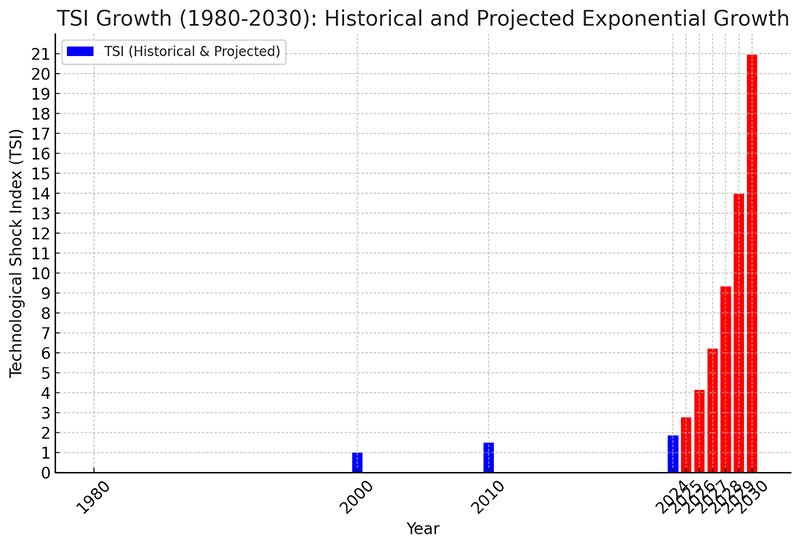Technological Shock Index
How TSI Works
How do we measure the speed and scale of technological disruption?
The world of work is changing faster than ever. Artificial intelligence, automation, and robotics are transforming industries at an unprecedented pace, compressing what once took decades into mere years. Entire sectors are being reshaped, new job roles are emerging, and longstanding professions are at risk of fading into obsolescence. The question isn’t if disruption will occur—but rather how quickly and how deeply it will impact the workforce.
To answer this, we introduce the Technological Shock Index (TSI), a breakthrough metric designed to quantify the intensity of workforce disruption caused by emerging technologies. Think of it as the Richter scale for economic tremors, a tool that helps businesses, policymakers, and individuals anticipate the seismic shifts ahead and prepare accordingly.
Why the TSI Matters Now
History has shown us that technological revolutions, from the Industrial Revolution to the rise of automation, bring both opportunities and upheaval. But today’s disruption is different. The rate at which AI and automation are replacing or transforming jobs is accelerating, leaving workers and industries with little time to adapt. Without a clear way to measure and manage this transformation, businesses risk lagging behind, policymakers risk implementing outdated solutions, and workers risk being left behind.
How the TSI Works: A Simple Formula for Measuring Disruption
The Technological Shock Index is based on three core factors:
- Job Displacement (X) – The percentage of jobs at risk due to automation and AI.
- Job Creation or Transformation (Z) – The percentage of new roles emerging to offset these losses.
- Timeline (Y) – The number of years over which this shift unfolds.
The formula for TSI is:

Interpreting the TSI Score
- TSI 0-1: Gradual Evolution – Technology enhances productivity without causing major workforce disruption.
- TSI 1-2: Noticeable Disruption – Some industries experience pressure, but adaptation is possible with reskilling.
- TSI 2-3: High Disruption – Entire sectors face workforce reductions, requiring large-scale retraining and economic shifts.
- TSI 3-4: Severe Disruption – Structural economic strain emerges, forcing governments and businesses into crisis management.
- TSI 4-5: Critical Shock – Automation outpaces human adaptation entirely, leading to mass unemployment and potential societal upheaval.
By calculating a single, actionable score, the TSI helps organizations and governments plan for the future with data-driven precision, ensuring that technology serves progress rather than destabilization.
Interpreting the TSI Score
- TSI 0-1: Gradual Evolution – Technology enhances productivity without causing major workforce disruption.
- TSI 1-2: Noticeable Disruption – Some industries experience pressure, but adaptation is possible with reskilling.
- TSI 2-3: High Disruption – Entire sectors face workforce reductions, requiring large-scale retraining and economic shifts.
- TSI 3-4: Severe Disruption – Structural economic strain emerges, forcing governments and businesses into crisis management.
- TSI 4-5: Critical Shock – Automation outpaces human adaptation entirely, leading to mass unemployment and potential societal upheaval.
By calculating a single, actionable score, the TSI helps organizations and governments plan for the future with data-driven precision, ensuring that technology serves progress rather than destabilization.
Who Can Benefit from the TSI?
- Businesses & Industry Leaders – Stay ahead of workforce changes and invest in reskilling strategies before disruption peaks.
- Policymakers & Governments – Identify at-risk industries and craft policies that support workers through transitions.
- Workers & Job Seekers – Understand which skills will remain relevant and where to focus future career development.
- Communities & Educators – Align training programs with the real demands of the evolving job market.
The Future Is Unwritten—But It Can Be Measured
The TSI isn’t just about tracking disruption, it’s about managing it. By measuring the forces reshaping our economy, we can take proactive steps to ensure technology drives progress without leaving people behind. Whether you’re a business leader preparing for the next wave of AI, a policymaker shaping workforce strategies, or a professional planning your career trajectory, the Technological Shock Index can provide some additional clarity needed to navigate the road ahead.
It may be reassuring to think that technological advancements progress at a steady, manageable pace, allowing ample time for adaptation. However, as the graph below illustrates, the rate of technological disruption has been accelerating since 1980, and projections through 2030 suggest an exponential trajectory that will demand faster and more proactive adjustments. If the current trend continues unabated, the TSI is projected to reach 2.5-3.0 by 01/2026 – meaning the shift from moderate to high disruption could happen within the next 12 to 24 months. This indicates that economic and workforce disruptions are accelerating at an unprecedented pace, requiring immediate adaptation strategies from business leaders, policymakers, and workers to mitigate the fallout. Without proactive intervention, job displacement, wage suppression, and social instability could escalate much faster than most institutions are prepared to handle.

👉 Peak into what the future could look like based on overall TSI score. Note: While these projections are strictly hypothetical, they are grounded in as much evidence and historical trends as possible.
References: References Page Found Here
